
Concrete surfaces can be quite drab and depressing, but the staining of concrete allows you to add colour that can greatly enhance the looks of the floor.
The process itself is quite affordable and does not take more than two days to complete. You can even stain concrete that has been freshly laid, but this must be done only after the concrete has cured fully, a process that takes anywhere between 3 and 4 weeks.
Stained concrete has a luxurious richness that you cannot achieve with any other medium that you may use for colouring the concrete. Paints produce solid and opaque effects, but stained concrete is infused with translucent and luminous tones that depend on the application techniques and the surface to which the stains are applied. You can even mimic polished marble, stained wood, natural stone, or even tanned leather.
There are two categories of stains that are in wide use. Stains can be chemicals with an acid-base or water-based acrylics. You can apply the stains to new or old concrete, or even surfaces that have been coloured before. The application of the stain revitalizes surfaces that are lacklustre and dull. The stains penetrate the porous structure of the concrete and this in-depth staining gives the stained concrete surface excellent stability against ultraviolet rays of the sun. It increases the wear resistance of concrete and this allows the use of staining for both interior and exterior concrete surfaces. As a result, you can easily use staining for your patios and walkways, rooms of family rooms, countertops of kitchens, and even create walls or fireplaces that are eye-catching.
Acid staining agents are a mixture of metallic salts that are soluble in acids, hydrochloric acid and water. These stains penetrate the surface and chemically react with the calcium hydroxide that is part of the cement in the concrete. The acid component in the stain etches the concrete surface, and this, in turn, allows the metallic salts containing the colour to penetrate the concrete easily. The chemical reactions allow the stain to become a permanent part of the body of the concrete and thus reduces its chances of fading. It also ensures that the colour of the concrete will not peel or chip, as is the problem with painted surfaces.
Acid-based stains will give you colours like soft-blue greens, terra cottas, browns and tans, but if you want stains that have a wider palette go in for the use of water-based stains. They come in a wide spectrum of colours that can even give you metallic tints, dozens of standard colours, and even give you a black or white-coloured concrete. These water-based stains are blends of pigments and acrylic polymers and they easily penetrate the concrete to give it a permanent colour, that can be anywhere from opaque to translucent.
Concrete staining is semi-permanent and is more meant as a means to enhance the surface, and not to disguise any flaws, blemishes or cracks in the concrete. They will not in any way conceal the texture that the concrete surface has, or cover any underlying colour. So, if your concrete is cracked or spalled, it can only become a good candidate for staining, if all the defects in it are first rectified and then allowed to cure. Even then, patchwork may show through, especially in light colours. Stains have to be able to soak into the concrete, and anything that inhibits this, like oil, grease, sealants, curing membranes or others may prevent colour saturation, and not give you the effect that you would like to see.
There are four steps for creating any stained concrete. The surface has to be cleaned and prepared, the stain has to be applied, any residue has to be removed, and then the surface has to be sealed. Sweeping the floor with a rotary floor scrubber with pads designed for scrubbing of concrete can give you the best results. The use of trisodium phosphate or other cleaners after the initial cleaning will give you a surface that is then ready for the staining process. A final rinsing must be followed with vacuuming out of all the water and debris. Using a mop just moves the water and debris around. Vacuuming can also help the floor to dry faster.
After the floor has been cleaned and dried thoroughly, you need to mask all the walls, door frames and other surfaces that can come into contact with the stain. Follow the manufacturer’s instructions for the preparation of the stain. Stains can be applied with brushes or through sprayers. Sponges and brushes give you precise control over the application. Allow the first coat to dry for at least half-n-hour and let it cure for at least 24 hours before you add a second coat if you have not got the required colour intensity.
The stain must then be neutralized with baking soda or ammonia after it has been cured if you have used an acid-based stain. Allow it to dry for at least a day before you apply two coats of a sealer.
Leave a Reply